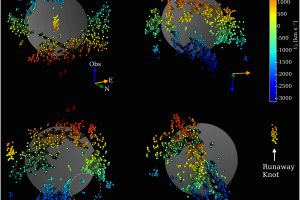The morphology of the oxygen-rich supernova remnant N132D. The study: “Three-dimensional Kinematic Reconstruction of the Optically Emitting, High-velocity, Oxygen-rich Ejecta of Supernova Remnant N132D” of C. J. Law (CfA) recently appeared on ApJ

Supernove explosions are repeatedly observed in distant galaxies, which lie at such large distances that it is impossible for us to resolve the geometry of the ejected material and its interaction with the surrounding interstellar and circumstellar clouds. With the only exception of SN 1978A, in the Milky Way and in the nearby galaxies (namely the Magellanic Clouds), we did not observed supernove during the telescopes era, but we can study their remnants with high spatial resolution their remnant in order to derive crucial information on the physics involved in supernova explosions and the properties of their progenitor stars.
N132D is the brightest supernova remnant in X and γ rays in the Large Magellanic Cloud, at a distance of about 163000 light years from us. Its ejecta (e.g. the stellar material ejected during the explosion at velocities of several thousands km/sec) are rich in oxygen and with low concentration of hydrogen. This suggests that the progenitor star lost its outer envelops (hydrogen-rich) during its late evolution, before the supernova explosion. Thus, while in hydrogen-rich supernova remnants the morphology and dynamics of the ejecta probe the explosion in the stellar outer layer, in the oxygen-rich remnants such as N132D, they probe the explosion in the deep layers of the star (supergiant stars synthesize heavy elements into deep layers, which means that while the outer layers of these stars are rich in hydrogen and helium, the deeper layers are rich in heavier elements such as oxygen).
The international team of astronomers led by C. J. Law (Harvard-Smithsonian Center for Astrophysics), counting also the astronomer S. Orlando (INAF – Astronomical Observatory of Palermo), has analyzed new observations of the oxygen-rich ejecta of N132D acquired with the Magellan Telescope, with the aim of studying their morphology and dynamics. The team has shown that the oxygen-rich ejecta mainly lie in a torus which is incomplete along its circumference, inclined about 28 degrees with respect to the line of sight, and with a radius of about 14.5 light years. The average expansion velocity of the ejecta is 1750 km/sec, which, with the hypothesis of a homologous expansion (e.g. without changing its shape except for a scaling factor) suggests that the remnant is 2450±195 years old. Besides, the authors have identified a silicon-rich knot of ejected material moving at about 3650 km/sec in a direction almost perpendicular to the torus. Both its chemical composition and motion suggest that this knot was ejected from deep inside the progenitor star during the supernova explosion. The study is described in the paper: “Three-dimensional Kinematic Reconstruction of the Optically Emitting, High-velocity, Oxygen-rich Ejecta of Supernova Remnant N132D“, which recently appeared on The Astrophysical Journal.
The image (click here to visualize the entire figure) shows a 3D Doppler reconstruction of the oxygen-rich ejecta of N132D. The different panels show the ejecta at different inclinations. The sphere helps discerning between ejecta in the front and in the back with respect the line of sight.
Mario Giuseppe Guarcello ( follow mguarce)
